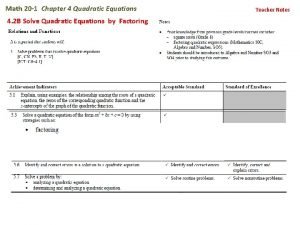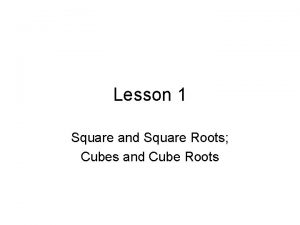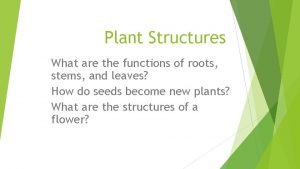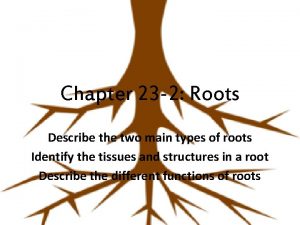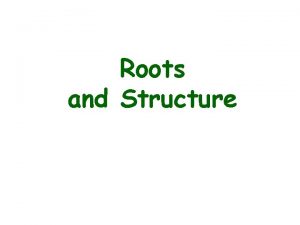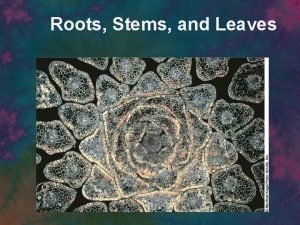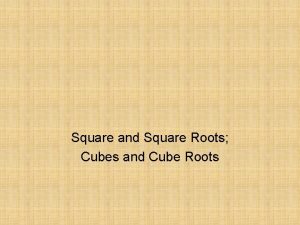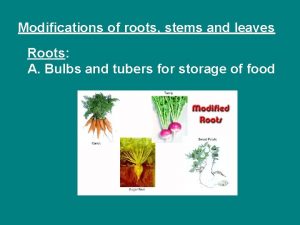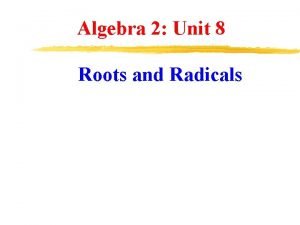Roots and Structure Chapter 7 Roots The main











































- Slides: 43

Roots and Structure Chapter 7

Roots!!!!!!! The main driving forces for water flow from the soil through the plant to the atmosphere include: Differences in: [H 2 O vapor] Hydrostatic pressure Water potential All of these act to allow the movement of water into the plant. Copyright © 2002 Pearson Education, Inc. , publishing as Benjamin Cummings

Roots: Function • Roots anchor the plant in the substratum or soil. • Roots absorb water and dissolved nutrients or solutes (nitrogen, phosphorous, magnesium, boron, etc. ) needed for normal growth, development, photosynthesis, and reproduction. • In some plants, roots have become adapted for specialized functions. Copyright © 2002 Pearson Education, Inc. , publishing as Benjamin Cummings

Plant Root Zones • Meristematic zone – Cells divide both in direction of root base to form cells that will become the functional root and in the direction of the root apex to form the root cap • Elongation zone – Cells elongate rapidly, undergo final round of divisions to form the endodermis. Some cells thicken to form casparian strip • Maturation zone – Fully formed root with xylem and phloem – root hairs first appear here

Primary Growth in Roots • Root Cap: covers root tip & protects the meristem as the root pushes through the abrasive soil during primary growth. – The cap also secretes a lubricating slime. • Growth in length is concentrated near the root’s tip, where three zones of cells at successive stages of primary growth are located. – zone of cell division – zone of elongation – zone of maturation Copyright © 2002 Pearson Education, Inc. , publishing as Benjamin Cummings

• thimble-shaped mass of parenchyma cells at the tip of each root • protects the root from mechanical injury • Golgi bodies release a mucilaginous lubricant (mucigel) cells lasts less than a week, then these die • possibly important in perception of gravity (i. e. , geotropism or gravitropism) • amyloplasts (also called statoliths) appear to accumulate at the bottom of cells Root Cap

Primary Growth in Roots • The zone of cell division includes the apical meristem and its derivatives, primary meristems. • Near the middle is the quiescenter (or radicle) – This forms the primary root of a young plant. • cells that divide more slowly than other meristematic cells. – These cells are relatively resistant to damage from radiation and toxic chemicals. – They may act as a reserve that can restore the meristem if it becomes damaged. Copyright © 2002 Pearson Education, Inc. , publishing as Benjamin Cummings

Primary Growth in Roots • The zone of cell division blends into the zone of elongation where cells elongate, sometimes to more than ten times their original length. – It is this elongation of cells that is mainly responsible for pushing the root tip, including the meristem, ahead. – The meristem sustains growth by continuously adding cells to the youngest end of the zone of elongation. Copyright © 2002 Pearson Education, Inc. , publishing as Benjamin Cummings

Primary Growth in Roots • In the zone of maturation, cells begin to specialize in structure and function. – In this root region, the three tissue systems produced by primary growth complete their differentiation, their cells becoming functionally mature • Three primary meristems give rise to the three primary tissues of roots. – The epidermis develops from the dermal tissues. – The ground tissue produces the endodermis and cortex. – The vascular tissue produces the stele, the pericycle, pith, xylem, and phloem. Copyright © 2002 Pearson Education, Inc. , publishing as Benjamin Cummings

Primary Growth in Roots • The protoderm, the outermost primary meristem, produces the single cell layer of the epidermis • Water and minerals absorbed by the plant must enter through the epidermis. • Root hairs enhance absorption by greatly increasing the surface area. • The procambium gives rise to the stele, which in roots is a central cylinder of vascular tissue where both xylem and phloem develop. Copyright © 2002 Pearson Education, Inc. , publishing as Benjamin Cummings

• The procambium gives rise to the stele, which in roots is a central cylinder of vascular tissue where both xylem and phloem develop. Stele Copyright © 2002 Pearson Education, Inc. , publishing as Benjamin Cummings

Primary Growth in Roots • The ground tissue between the protoderm and procambium gives rise to the ground tissue system. • These are mostly parenchyma cells between the stele and epidermis. • They store food and are active in the uptake of minerals that enter the root with the soil solution. • The innermost layer of the cortex, the endodermis, is a cylinder one cell thick that forms a boundary between the cortex and stele. Copyright © 2002 Pearson Education, Inc. , publishing as Benjamin Cummings

cortex Dicot Root Anatomy endodermis pericycle epidermis cortex stele xylem phloem

Monocot Root Anatomy cortex stele epidermis cortex endodermis pericycle pith phloem xylem

Dicot Monocot

Mycorrhizal associations • Not unusual – 83% of dicots, 79% of monocots and all gymnosperms • Ectotrophic Mycorrhizal fungi – Form a thick sheath around root. Some mycelium penetrates the cortex cells of the root – Root cortex cells are not penetrated, surrounded by a zone of hyphae called Hartig net – The capacity of the root system to absorb nutrients improved by this association – the fungal hyphae are finer than root hairs and can reach beyond nutrient-depleted zones in the soil near the root

Mycorrhizal associations • Vesicular arbuscular mycorrhizal fungi – Hyphae grow in dense arrangement , both within the root itself and extending out from the root into the soil – After entering root, either by root hair or through epidermis hyphae move through regions between cells and penetrate individual cortex cells. – Within cells form oval structures – vesicles – and branched structures – arbuscules (site of nutrient transfer) – P, Cu, & Zn absorption improved by hyphae reaching beyond the nutrientdepleted zones in the soil near the root

Water transport processes • Moves from soil, through plant, and to atmosphere by a variety of mediums – – Cell wall Cytoplasm Plasma membranes Air spaces • How water moves depends on what it is passing through

Water absorption from soil • Water clings to the surface of soil particles. • As soil dries out, water moves first from the center of the largest spaces between particles. • Water then moves to smaller spaces between soil particles. • Root hairs make intimate contact with soil particles – amplify the surface area for water absorption by the plant.

Water across plant membranes • There is some diffusion of water directly across the bilipid membrane. • Auqaporins: Integral membrane proteins that form water selective channels – allows water to diffuse faster – Facilitates water movement in plants • Alters the rate of water flow across the plant cell membrane – NOT direction

Osmosis and Tonicity • Osmosis is the diffusion of water across a plasma membrane. • Osmosis occurs when there is an unequal concentration of water on either side of the selectively permeable plasma membrane. • Remember, H 2 O CAN cross the plasma membrane. • Tonicity is the osmolarity of a solution-the amount of solute in a solution. • Solute--dissolved substances like sugars and salts. • Tonicity is always in comparison to a cell. • The cell has a specific amount of sugar and salt.

Tonic Solutions • A Hypertonic solution has more solute than the cell. A cell placed in this solution will give up water (osmosis) and shrink. • A Hypotonic solution has less solute than the cell. A cell placed in this solution will take up water (osmosis) and become turgid. • An Isotonic solution has just the right amount of solute for the cell. A cell placed in this solution will stay the same.

Plant cell in hypotonic solution • Flaccid cell in 0. 1 M sucrose solution. • Water moves from sucrose solution to cell – swells up –becomes turgid • This is a Hypotonic solution - has less solute than the cell. So higher water conc. • Pressure increases on the cell wall as cell expands to equilibrium

Plant cell in hypertonic solution • Turgid cell in 0. 3 M sucrose solution • Water movers from cell to sucrose solution • A Hypertonic solution has more solute than the cell. So lower water conc • Turgor pressure reduced and protoplast pulls away from the cell wall

Plant cell in Isotonic solution • Water is the same inside the cell and outside • An Isotonic solution has the same solute than the cell. So no osmotic flow • Turgor pressure and osmotic pressure are the same • This is of NO real benefit to a plant cell and it enters a state known as Flacid. Chemical reactions will still occur, BUT the plant cell can’t help support the structure of the entire plant.

Water uptake in the roots • Root hairs increase surface area of root to maximize water absorption. • From the epidermis to the endodermis there are three pathways in which water can flow: • 1: Apoplast pathway: • Water moves exclusively through cell walls without crossing any membranes – The apoplast is a continuous system of cell walls and intercellular air spaces in plant tissue

Water uptake in the roots • 2: Transmembrane pathway: • Water sequentially enters a cell on one side, exits the cell on the other side, enters the next cell, and so on. • 3: Symplast pathway: • Water travels from one cell to the next via plasmodesmata. – The symplast consist of the entire network of cell cytoplasm interconnected by plasmodesmata

Water uptake in the roots • At the endodermis: • Water movement through the apoplast pathway is stopped by the Casparian Strip – Band of radial cell walls containing suberin , a waxlike water-resistant material • The casparian strip breaks continuity of the apoplast and forces water and solutes to cross the endodermis through the plasma membrane – So all water movement across the endodermis occurs through the symplast

Water transport to the xylem • After water moves through the Casparian Strip via the symplast pathway – Water traveling from one cell to the next via plasmodesmata • It enters the xylem system • Compared with water movement across root tissue the xylem is a simple pathway of low resistance • Water movement through xylem needs less pressure than movement through living cells. • Cohesion-tension theory:

Water transport to the xylem • Cohesion-tension theory: • Relies on the fact that water is a polar molecule • Water is constantly lost by transpiration in the leaf. • When one water molecule is lost another is pulled along • Transpiration pull, utilizing capillary action and the inherent surface tension of water, is the primary mechanism of water movement in plants.

Comparison of Root Systems • Types of roots: – Taproot - A thick primary root that grows long and is found mainly in dicots – Adventitious (Fibrous) roots – branch extensively and are found mainly in monocots From the wikimedia free licensed media file repository

The Tap root • A taproot is a very large, somewhat straight to tapering plant root that grows downward. It forms a center from which other roots sprout laterally • Plants with taproots are difficult to transplant. The presence of a taproot is why weeds are hard to uproot—the top is pulled, but the long taproot stays in the ground, and resprouts • Dicots, one of the two divisions of angiosperms, start with a taproot, which is one main root forming from the enlarging radicle of the seed. • The tap root can be persistent throughout the life of the plant but is most often replaced later in the plant's development by a fibrous root system From the wikimedia free licensed media file repository

Adventitious (fibrous) Roots: • Roots that arise from anything other than the radicle • A fibrous root system is universal in monocotyledonous plants and ferns • Adventitious rooting may be a stressavoidance acclimation for some species, driven by such inputs as: • hypoxia/anoxia or nutrient deficiency. • Arise out-of-sequence from the more usual root formation of branches of a primary root, and instead originate from the stem, branches, leaves, or old woody roots. • Adventitious roots dry out quicker, thus cannot tolerate drought • Better able to hold within soil, giving plant better stability From the wikimedia free licensed media file repository

Modified Roots • Food storage – swollen with nutrients and water to prepare for unfavorable conditions. – Some are swollen main roots - carrots. – Others are swollen branched roots or advertitious – sweet potato • Photosynthetic roots • Parasitic roots – Some plants live on other plants and get food materials from their hosts. Parasitic roots are used to absorb food materials form their hosts. From the wikimedia free licensed media file repository

Modified Roots • Buttress roots – large roots on all sides of a tall or shallowly rooted tree. – Typically they are found in rain forests where soils are poor so roots don't go deep. – They prevent the tree from falling over and help gather more nutrients. – They are there to anchor the tree and soak minerals and nutrients from the ground, a function that would prove difficult if the tree was unsoundly rooted. – Examples: silk cotton From the wikimedia free licensed media file repository

Modified Roots • Aerial roots – roots above the ground. – They are almost always adventitious. – They can absorb water from the air. – They are also used to hold on to their support. – They are found in diverse plant species which include: – the orchids – tropical coastal swamp trees such as mangroves. From the wikimedia free licensed media file repository

Modified Roots • Respiratory roots – Some plants in swampy areas have branch roots that grow upwards, through the mud and into the air. – The exposed parts of the roots are spongy and they take in air for respiration - red mangrove • Clasping roots – grow from the nodes of the soft stem to cling on to other plants. Examples: pepper, ivy From the wikimedia free licensed media file repository

• Legumes Symbiotic Roots – Legumes seedlings germinate without any association to rhizobia – Under nitrogen limiting conditions, the plant and the bacteria seek each other out by an elaborate exchange of signals – The first stage of the association is the migration of the bacteria through the soil towards the host plant From the wikimedia free licensed media file repository

Symbiotic Roots • Nodule formation results a finely tuned interaction between the bacteria and the host plant – Involves the recognition of specific signals between the symbiotic bacteria and the host plant • The bacteria forms NH 3 which can be used directly by the plant • The plant gives the bacteria organic nutrients.

Nodule formation • During root nodule formation, two process occur simultaneously • Infection and Nodule Organogenesis – (A) Rhizobia attach to the root hairs and release nod factors that produce a pronounced curling of the root hair cell – (B) Rhizobia get caught and curl, degrade the root hair cell wall allowing the bacterial cells direct access to the outer surface of the plant plasma membrane

Nodule formation • (C) Then the infection thread forms – Formed from Golgi depositing material at the tip at the site of infection. Local degradation of root hair cell wall also occurs • (D) Infection thread reaches the end of the cell, and thread plasma membrane fuses with plasma membrane of root hair cell – Then bacterial cells are released into the fused plasma membranes

Nodule formation • (E) Rhizobia are released into the apoplast and enter the middle lamella, – This leads to the formation of a new infection thread, which forms an open channel with the first • (F) Infection thread expands and branches until it reaches target cells – Vesicles composed of plant membrane enclose bacterial cells and they are released into the cytoplasm

The End. Any Questions?
 Lesson 3 existence and uniqueness
Lesson 3 existence and uniqueness Square roots and cube roots guided notes
Square roots and cube roots guided notes Sum of the roots and product of the roots formula
Sum of the roots and product of the roots formula All the perfect squares
All the perfect squares Biology roots vanessa jason
Biology roots vanessa jason The roots of american imperialism 1. economic roots
The roots of american imperialism 1. economic roots Implied main idea
Implied main idea Captain thomas davies roots
Captain thomas davies roots Functions of roots
Functions of roots Two main types of roots
Two main types of roots Going to uses
Going to uses Void main int main
Void main int main Hình ảnh bộ gõ cơ thể búng tay
Hình ảnh bộ gõ cơ thể búng tay Frameset trong html5
Frameset trong html5 Bổ thể
Bổ thể Tỉ lệ cơ thể trẻ em
Tỉ lệ cơ thể trẻ em Gấu đi như thế nào
Gấu đi như thế nào Tư thế worm breton
Tư thế worm breton Hát lên người ơi
Hát lên người ơi Các môn thể thao bắt đầu bằng tiếng bóng
Các môn thể thao bắt đầu bằng tiếng bóng Thế nào là hệ số cao nhất
Thế nào là hệ số cao nhất Các châu lục và đại dương trên thế giới
Các châu lục và đại dương trên thế giới Công thức tính thế năng
Công thức tính thế năng Trời xanh đây là của chúng ta thể thơ
Trời xanh đây là của chúng ta thể thơ Mật thư anh em như thể tay chân
Mật thư anh em như thể tay chân Phép trừ bù
Phép trừ bù Phản ứng thế ankan
Phản ứng thế ankan Các châu lục và đại dương trên thế giới
Các châu lục và đại dương trên thế giới Thơ thất ngôn tứ tuyệt đường luật
Thơ thất ngôn tứ tuyệt đường luật Quá trình desamine hóa có thể tạo ra
Quá trình desamine hóa có thể tạo ra Một số thể thơ truyền thống
Một số thể thơ truyền thống Bàn tay mà dây bẩn
Bàn tay mà dây bẩn Vẽ hình chiếu vuông góc của vật thể sau
Vẽ hình chiếu vuông góc của vật thể sau Biện pháp chống mỏi cơ
Biện pháp chống mỏi cơ đặc điểm cơ thể của người tối cổ
đặc điểm cơ thể của người tối cổ Thế nào là giọng cùng tên?
Thế nào là giọng cùng tên? Vẽ hình chiếu đứng bằng cạnh của vật thể
Vẽ hình chiếu đứng bằng cạnh của vật thể Fecboak
Fecboak Thẻ vin
Thẻ vin đại từ thay thế
đại từ thay thế điện thế nghỉ
điện thế nghỉ Tư thế ngồi viết
Tư thế ngồi viết Diễn thế sinh thái là
Diễn thế sinh thái là Các loại đột biến cấu trúc nhiễm sắc thể
Các loại đột biến cấu trúc nhiễm sắc thể


